Ingredient Spotlight: Turmeric
Turmeric is a rhizome and part of the ginger family and has been cultivated in Asia for thousands of years. It was first used as a dye, but was soon identified for its medicinal and culinary uses.
You can get Turmeric in its fresh form in some grocery stores. It looks similar to Ginger but is smaller and a deep orange color. Most turmeric however, is used in the form of powder, acting as a key ingredient in many Indian and Asian dishes, and found in most commercial curry powders. It is most often used in savory dishes.
In Ayurvedic practices, turmeric is used in a variety of medicinal applications. The most important medicinal compound is called curcumin, which has been shown to lower inflammation in the body. Because of this, turmeric is often used to treat a variety of ailments that result from, or are exacerbated by inflammation including kidney and cardiovascular disease, athritis, cancer, irritable bowel syndrome, and many other clinical disorders.
Many diseases can either be sourced back to, or are exacerbated by chronic inflammation. Besides Turmeric, whole grains, green leafy vegetables, garlic, nuts, berries, and cinnamon are also great anti-inflammatories, so load up on those too!
Turmeric is also used topically to cleanse wounds and treat skin sores, as research has indicated that it may have anti fungal and antibacterial properties. It is also still used as a dye today. It has a rich yellow hue which is used to color cheeses, yogurts, margarine, prepared mustards and numerous other products. But in order to get the full absorption of Turmeric’s beneficial properties there are 2 key details to remember:
1-Combine with a Fat
Turmeric is fat-soluble which means that it needs some fat to travel through the stomach, into the small intestine and into the blood to be of benefit. Olive oil, coconut oil and plant based milks are most commonly used as the fat source.
2-Add Black Pepper
Because of a compound called pipeline, adding black pepper increases curcumin’s bio-availabilty 1000 times. The suggested serving size is 1 teaspoon of dry Turmeric, or about a 1/2 inch piece fresh(1.5-3.0 grams). There are a couple of easy ways to get Turmeric into your diet. You can just grate some onto your salad or soup, or blend some up in your smoothie.
One idea is to steep freshly grated turmeric with some black pepper and ginger in hot water, then add a little coconut oil and agave, and whip in the blender for a frothy hot Turmeric Tea .
Some devotees swear by a mixture called ‘Golden Paste’ that is used on both humans and animals, who may be suffering from ailments usually centered around inflammation. The basic procedure calls for mixing about 1/2 cup of powdered turmeric and 1 cup of water in a small saucepan. Over gentle heat, stir this until a paste is formed, about 7-10 minutes. More water may be added along the way to maintain the consistency. After cooking add about 1 1/2 teaspoons of freshly ground black pepper and 1/3 cup olive, or coconut oil. The paste will keep in the refrigerator for about 2 weeks, or you can freeze it in portions for later use.
The dosage needed varies, but users suggest starting with 1/2 teaspoon twice a day, and working up to as much as 1 teaspoon, 3 times per day. The paste is also used on horses and dogs, but with different dosages.
Many people also enjoy what is called ‘Golden Milk’. The general recipe calls for you to blend about 2 cups of plant milk, with 1 teaspoon dry or 1/2 inch fresh turmeric, a pinch of black pepper, a small piece of fresh ginger (or 1/4 tsp dry), a little cinnamon and a sweetener of your choice in a blender until smooth. Then heat to almost boiling in a small saucepan and let cool for 3-5 minutes before drinking.
With summer on its way, and warm days already popping up, I was struck with a great idea….Turmeric Thai Iced Tea! What a fantastic way to get a dose of this anti-inflammatory powerhouse! I’ll be back with that recipe tomorrow!
Other Recipes with Turmeric


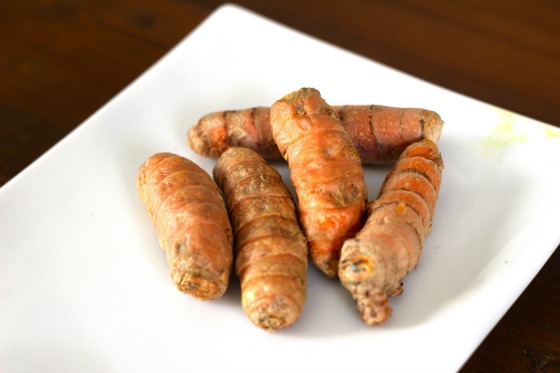
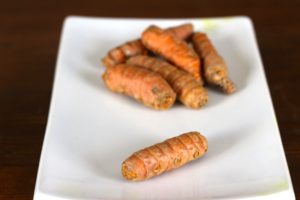
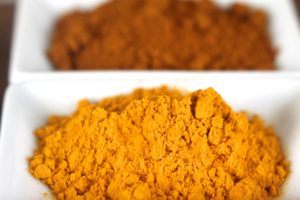
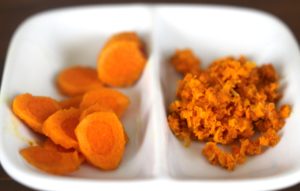
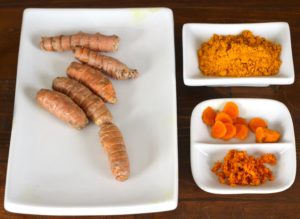


Lots of good info here! Who knew that this little used spice in the cabinet was so important?
I have heard great things about Turmeric and Ginger tea. Can’t wait to try it. Thanks for the great info.
Its so easy to add to your diet Gina. Juices, smoothies, salads, hot dishes, tea…the list is really endless. Find the one you like and add it to your life!